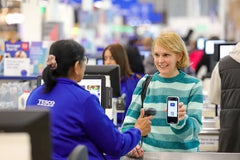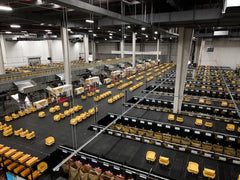
Amazon's Christmas in July: A Fashion-Forward Prime Day Revolution
Table of Contents
- Key Highlights:
- Introduction
- The Rise of Prime Day: A Retail Phenomenon
- Fashion Takes Center Stage
- Consumer Spending Patterns on Prime Day
- Luxury Resale and New Fashion Offerings
- Competing with Other Retailers
- The Future of Online Shopping
- The Impact of Social Media on Shopping Trends
- Sustainability and Ethical Fashion During Prime Day
- FAQ
Key Highlights:
- Amazon's Prime Day has evolved into a significant retail event, generating an expected $23.8 billion in sales, comparable to two Black Fridays combined.
- Apparel and footwear emerged as top-selling categories, with 30% of buyers purchasing fashion items during the sale.
- The event featured first-time promotions from luxury resale brands, expanding Amazon's fashion offerings and attracting a diverse customer base.
Introduction
As the summer sun blazes, Amazon has transformed a typically low-key shopping period into a vibrant "Christmas in July," captivating consumers with enticing deals on fashion and accessories. The company's Prime Day, now extended to four days and running through Friday, has become a cornerstone of the retail calendar, luring shoppers with promises of savings on everything from household essentials to high-end fashion. This year, with an estimated $23.8 billion in total sales expected, Prime Day represents a seismic shift in how consumers engage with online shopping, particularly in the apparel sector.
The event has not only reinforced Amazon's dominance as an e-commerce giant but has also triggered a competitive response from other retailers eager to capture a slice of the lucrative pie. This article explores the implications of Prime Day on the fashion industry, consumer behavior, and the evolving landscape of online shopping.
The Rise of Prime Day: A Retail Phenomenon
Amazon's Prime Day, which began in 2015 as a celebration of its 20th anniversary, has rapidly morphed into one of the most anticipated retail events of the year. Originally a 24-hour event, it now spans four days, offering shoppers a plethora of discounts across various product categories. This strategic expansion has allowed Amazon to capitalize on consumer eagerness and significantly boost its sales figures.
According to data from Adobe Analytics, Prime Day's sales projections for this year are staggering, anticipated to match the combined sales of two Black Fridays. This remarkable statistic underscores the event's growing importance in the retail landscape, highlighting how consumers are increasingly inclined to shop online rather than in traditional brick-and-mortar stores.
Fashion Takes Center Stage
This year's Prime Day has seen a particularly strong performance in the fashion category. Numerator, a data analytics company, tracked shopper behavior across 22,411 households and surveyed 2,248 buyers during the event's initial days. The findings revealed that apparel and footwear sales were tied for the top spot, with 30% of shoppers purchasing items in these categories.
The fashion-focused aspect of Prime Day illustrates a broader trend: consumers are becoming more discerning about their purchases, seeking quality and style even amidst significant sales events. A notable 51% of shoppers reported that they took advantage of discounts on items they had been waiting to buy, while 37% bought their usual selections from Amazon, indicating a blend of impulse buying and calculated spending.
Consumer Spending Patterns on Prime Day
Despite the excitement surrounding Prime Day, consumer behavior reflects a cautious approach to spending. The average order size during the event was pegged at $57.12, with many households making multiple purchases, raising the average household spend to $126.26. Interestingly, two-thirds of the items purchased were priced under $20, while only a mere 3% of products exceeded $100.
This data suggests that while consumers are eager to take advantage of discounts, they are doing so with a level of restraint, choosing lower-priced items that fit within their budgets. The trend also highlights a shift in consumer priorities, focusing on practical purchases rather than extravagant splurges.
Luxury Resale and New Fashion Offerings
One of the standout features of this year's Prime Day is the introduction of luxury resale items, which marks a significant expansion of Amazon's fashion offerings. For the first time, the luxury resale platform Rebag has collaborated with Amazon to provide discounts on high-end designer pieces from brands such as Alexander McQueen, Chloé, and Valentino Garavani.
This move not only diversifies Amazon's fashion selection but also allows consumers to access luxury items at more attainable price points. The inclusion of established fashion brands like Michael Kors, Hervé Léger, and Naadam further enhances the appeal of Prime Day, attracting a broader range of shoppers, including those who may not typically shop for luxury items.
Competing with Other Retailers
Amazon's dominance during Prime Day has not gone unnoticed by competitors. Retailers across the spectrum are launching their own promotions to capture consumers' attention during this critical shopping window. This competitive landscape has heightened the stakes for all players in the retail sector, compelling them to innovate and offer compelling deals to maintain market share.
Brands are increasingly aware that aligning their promotional schedules with Prime Day can significantly impact sales. As a result, we are witnessing a shift where more retailers are participating in this shopping event, creating a sense of urgency for consumers to make purchases.
The Future of Online Shopping
As shopping habits continue to evolve, Prime Day stands as a prime example of how digital retail is reshaping consumer experiences. The growing popularity of events like Prime Day underscores the importance of convenience, speed, and variety in the online shopping arena.
With major retailers like Amazon setting the pace, the future of shopping is likely to be characterized by hyper-personalized experiences, seamless technology integration, and greater access to luxury and specialty items. As consumers become more accustomed to shopping online, retailers must adapt their strategies to meet these changing demands.
The Impact of Social Media on Shopping Trends
In recent years, social media has played a pivotal role in influencing consumer purchasing decisions. Platforms such as Instagram and TikTok have become vital tools for brands to showcase their products, particularly in fashion. Influencer marketing has gained significant traction, with many brands leveraging the reach of digital influencers to promote their offerings during events like Prime Day.
The visual nature of social media allows consumers to discover new styles and brands that they may not have encountered otherwise. This phenomenon has resulted in a more diverse fashion landscape, where emerging designers and vintage shops can compete alongside established names in the industry.
Sustainability and Ethical Fashion During Prime Day
As consumers become increasingly aware of the environmental impacts of fast fashion, there is a growing demand for sustainable and ethically produced clothing. Prime Day has seen a rise in promotions from brands that prioritize sustainable practices, catering to the conscientious shopper.
Many consumers are actively seeking out eco-friendly options, and retailers that align with these values are likely to see increased interest during major sales events. Brands that can effectively communicate their sustainability efforts and ethical production methods will likely have a competitive edge in the market.
FAQ
What is Amazon Prime Day? Amazon Prime Day is an annual sales event held by Amazon, offering exclusive discounts and promotions for Amazon Prime members. It features a wide range of products, including electronics, household items, and fashion.
When does Prime Day take place? Prime Day typically occurs in July, with the event lasting for several days. In 2023, it was extended to four days, allowing shoppers more time to take advantage of deals.
How can consumers prepare for Prime Day? Consumers can prepare by creating a wishlist of desired items, comparing prices before the event, and keeping an eye on early promotions. Being an Amazon Prime member also provides access to exclusive deals.
Are there any other retailers participating in Prime Day? Yes, many retailers offer competing promotions during Prime Day to attract shoppers. This has become a trend as more brands recognize the significance of this shopping event.
What is the significance of including luxury resale items? The inclusion of luxury resale items allows consumers to purchase high-end fashion at more affordable prices. It also reflects a growing interest in sustainable shopping practices, as resale contributes to reducing waste in the fashion industry.
How has consumer behavior changed during Prime Day? Consumer behavior during Prime Day has shown a trend toward more calculated spending, with shoppers focusing on practical purchases and lower-priced items rather than extravagant splurges. This shift indicates a more cautious approach to spending in the current economic climate.
Power your ecommerce with our weekly insights and updates!
Håll dig uppdaterad om vad som händer i handelsvärlden
E-postadress





